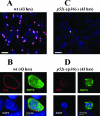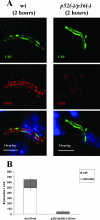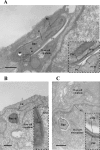Plasmodium yoelii sporozoites with simultaneous deletion of P52 and P36 are completely attenuated and confer sterile immunity against infection
- PMID: 17517871
- PMCID: PMC1951999
- DOI: 10.1128/IAI.00225-07
Plasmodium yoelii sporozoites with simultaneous deletion of P52 and P36 are completely attenuated and confer sterile immunity against infection
Abstract
Malaria infection starts when sporozoites are transmitted to the mammalian host during a mosquito bite. Sporozoites enter the blood circulation, reach the liver, and infect hepatocytes. The formation of a parasitophorous vacuole (PV) establishes their intracellular niche. Recently, two members of the 6-Cys domain protein family, P52 and P36, were each shown to play an important albeit nonessential role in Plasmodium berghei sporozoite infectivity for the rodent host. Here, we generated p52/p36-deficient Plasmodium yoelii parasites by the simultaneous deletion of both genes using a single genetic manipulation. p52/p36-deficient parasites exhibited normal progression through the life cycle during blood-stage infection, transmission to mosquitoes, mosquito-stage development, and sporozoite infection of the salivary glands. p52/p36-deficient sporozoites also showed normal motility and cell traversal activity. However, immunofluorescence analysis and electron microscopic observations revealed that p52/p36-deficient parasites did not form a PV within hepatocytes in vitro and in vivo. The p52/p36-deficient parasites localized as free entities in the host cell cytoplasm or the host cell nucleoplasm and did not develop as liver stages. Consequently, they did not cause blood-stage infections even at high sporozoite inoculation doses. Mice immunized with p52/p36-deficient sporozoites were completely protected against infectious sporozoite challenge. Our results demonstrate for the first time the generation of two-locus gene deletion-attenuated parasites that infect the liver but do not progress to blood-stage infection. The study will critically guide the design of Plasmodium falciparum live attenuated malaria vaccines.
Figures






Similar articles
-
The Micronemal Plasmodium Proteins P36 and P52 Act in Concert to Establish the Replication-Permissive Compartment Within Infected Hepatocytes.Front Cell Infect Microbiol. 2018 Nov 27;8:413. doi: 10.3389/fcimb.2018.00413. eCollection 2018. Front Cell Infect Microbiol. 2018. PMID: 30547015 Free PMC article.
-
Protracted sterile protection with Plasmodium yoelii pre-erythrocytic genetically attenuated parasite malaria vaccines is independent of significant liver-stage persistence and is mediated by CD8+ T cells.J Infect Dis. 2007 Aug 15;196(4):608-16. doi: 10.1086/519742. Epub 2007 Jul 9. J Infect Dis. 2007. PMID: 17624848
-
First-in-human evaluation of genetically attenuated Plasmodium falciparum sporozoites administered by bite of Anopheles mosquitoes to adult volunteers.Vaccine. 2013 Oct 9;31(43):4975-83. doi: 10.1016/j.vaccine.2013.08.007. Epub 2013 Sep 8. Vaccine. 2013. PMID: 24029408 Clinical Trial.
-
Invasion of mammalian host cells by Plasmodium sporozoites.Bioessays. 2002 Feb;24(2):149-56. doi: 10.1002/bies.10050. Bioessays. 2002. PMID: 11835279 Review.
-
Liver invasion by malarial parasites--how do malarial parasites break through the host barrier?Cell Microbiol. 2004 Dec;6(12):1119-25. doi: 10.1111/j.1462-5822.2004.00474.x. Cell Microbiol. 2004. PMID: 15527492 Review.
Cited by
-
Protective efficacy and safety of liver stage attenuated malaria parasites.Sci Rep. 2016 May 31;6:26824. doi: 10.1038/srep26824. Sci Rep. 2016. PMID: 27241521 Free PMC article.
-
Complete Plasmodium falciparum liver-stage development in liver-chimeric mice.J Clin Invest. 2012 Oct;122(10):3618-28. doi: 10.1172/JCI62684. Epub 2012 Sep 10. J Clin Invest. 2012. PMID: 22996664 Free PMC article.
-
Cross-species immunity in malaria vaccine development: two, three, or even four for the price of one?Infect Immun. 2008 Mar;76(3):873-8. doi: 10.1128/IAI.00431-07. Epub 2007 Dec 3. Infect Immun. 2008. PMID: 18056479 Free PMC article. Review. No abstract available.
-
The Ig domain protein CD9P-1 down-regulates CD81 ability to support Plasmodium yoelii infection.J Biol Chem. 2009 Nov 13;284(46):31572-8. doi: 10.1074/jbc.M109.057927. Epub 2009 Sep 17. J Biol Chem. 2009. PMID: 19762465 Free PMC article.
-
Targeted deletion of SAP1 abolishes the expression of infectivity factors necessary for successful malaria parasite liver infection.Mol Microbiol. 2008 Jul;69(1):152-63. doi: 10.1111/j.1365-2958.2008.06271.x. Epub 2008 May 5. Mol Microbiol. 2008. PMID: 18466298 Free PMC article.
References
-
- Baer, K., M. Roosevelt, A. B. Clarkson, Jr., N. van Rooijen, T. Schnieder, and U. Frevert. 2007. Kupffer cells are obligatory for Plasmodium yoelii sporozoite infection of the liver. Cell. Microbiol. 9:397-412. - PubMed
-
- Belmonte, M., T. R. Jones, M. Lu, R. Arcilla, T. Smalls, A. Belmonte, J. Rosenbloom, D. J. Carucci, and M. Sedegah. 2003. The infectivity of Plasmodium yoelii in different strains of mice. J. Parasitol. 89:602-603. - PubMed
-
- Carter, R., A. Coulson, S. Bhatti, B. J. Taylor, and J. F. Elliott. 1995. Predicted disulfide-bonded structures for three uniquely related proteins of Plasmodium falciparum, Pfs230, Pfs48/45 and Pf12. Mol. Biochem. Parasitol. 71:203-210. - PubMed
-
- Eksi, S., B. Czesny, G. J. van Gemert, R. W. Sauerwein, W. Eling, and K. C. Williamson. 2006. Malaria transmission-blocking antigen, Pfs230, mediates human red blood cell binding to exflagellating male parasites and oocyst production. Mol. Microbiol. 61:991-998. - PubMed
Publication types
MeSH terms
Substances
LinkOut - more resources
Full Text Sources
Other Literature Sources
Medical

